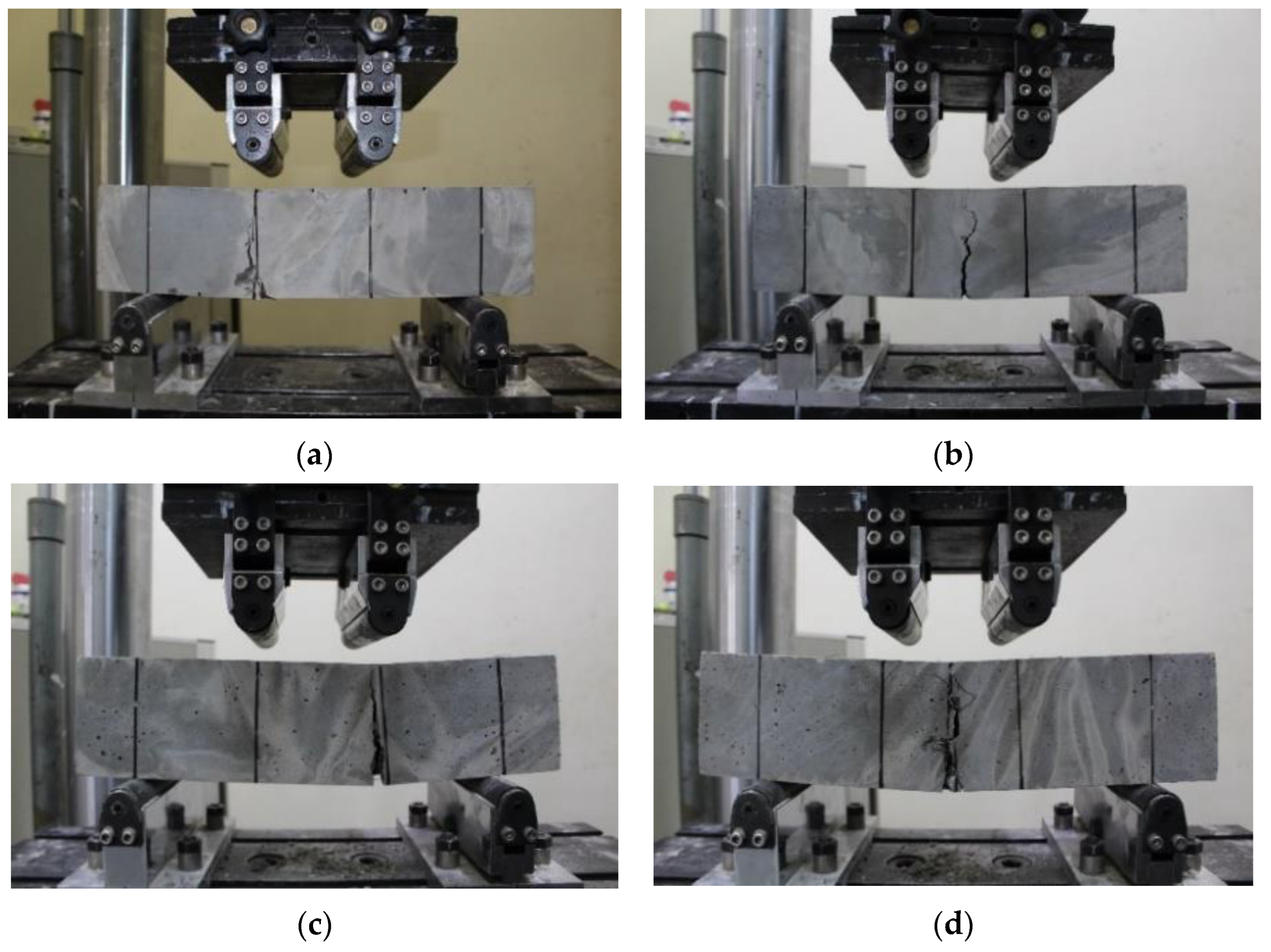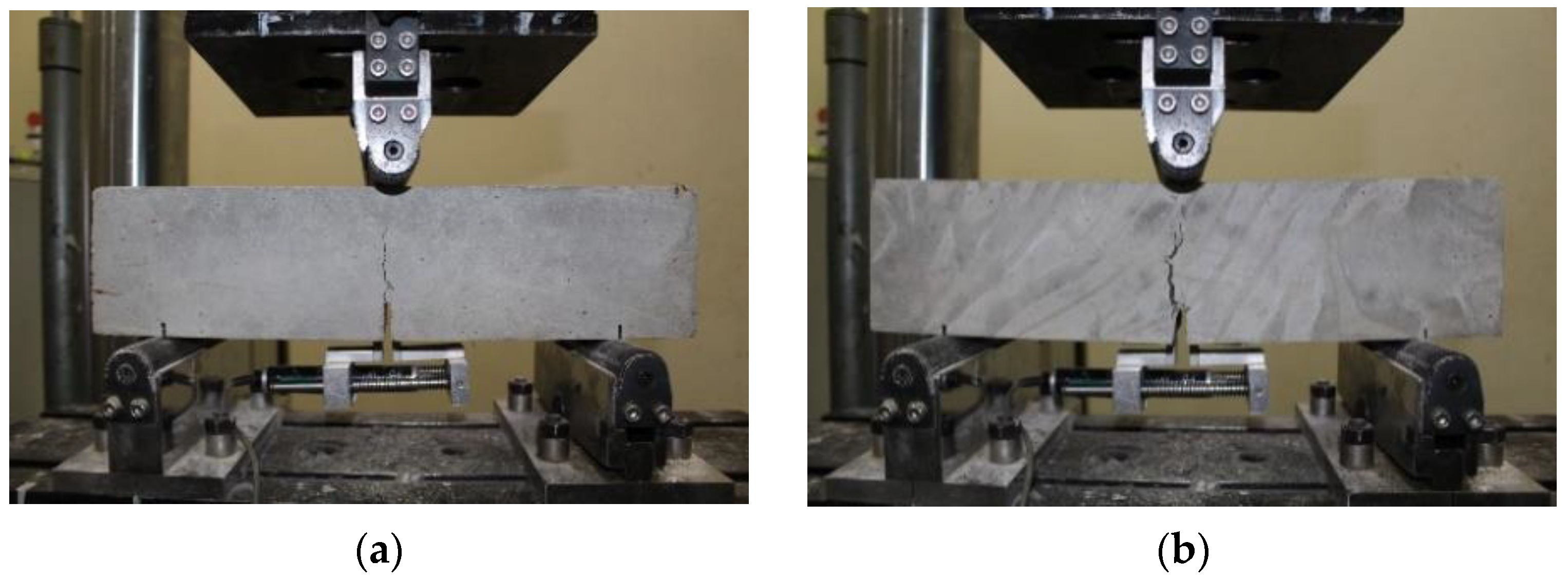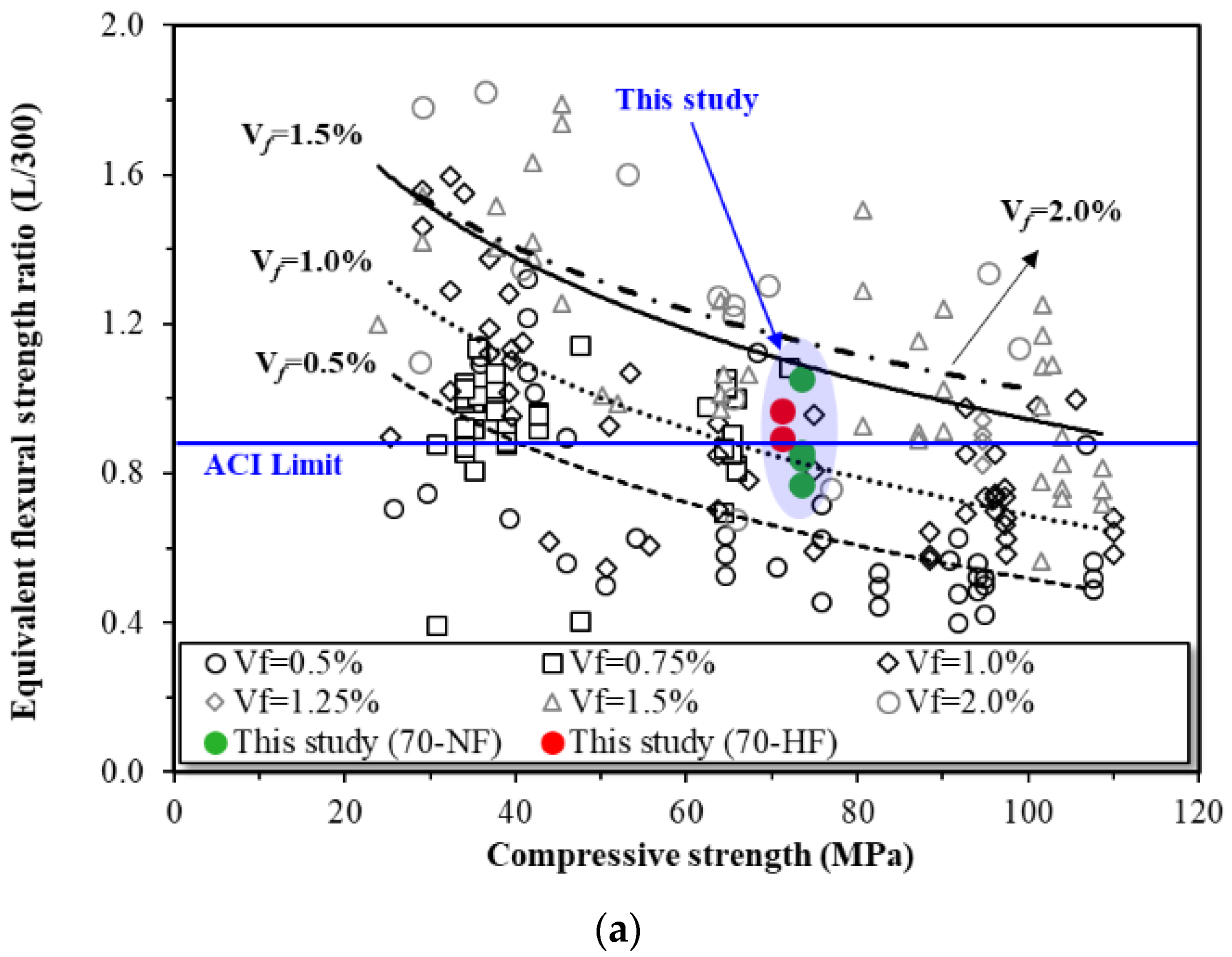Comparative Evaluation of Flexural Toughness of Steel Fiber-Reinforced Concrete Beams
Abstract
1. Introduction
2. Experimental Program
2.1. Materials and Specimen Preparation
2.2. Test Set-Ups
3. Experimental Results
3.1. Compressive Strength Tests
3.2. Flexural Behavior Tests
3.2.1. Load versus Deflection Curves
3.2.2. Failure Modes of SFRC Beam
4. Discussion
4.1. Energy Absorption Capacity
4.2. Effect of Steel Fiber Volume Fraction
4.3. Correlation between Three-Point Bending Tests and Four-Point Bending Tests
5. Conclusions
Author Contributions
Funding
Institutional Review Board Statement
Informed Consent Statement
Data Availability Statement
Conflicts of Interest
References
- Xiaa, D.; Liub, X.; Zhou, B. Flexural toughness of hybrid fiber reinforced high-performance concrete under three-point 414 bending. Appl. Mech. Mater. 2013, 357–360, 1110–1114. [Google Scholar] [CrossRef]
- Köksal, F.; Altun, F.; Yiğit, İ.; Şahin, Y. Combined effect of silica fume and steel fiber on the mechanical properties of high strength concretes. Constr. Build. Mater. 2008, 22, 1874–1880. [Google Scholar] [CrossRef]
- EN 14651 + A1; Test Method for Metallic Fibre Concrete. Measuring the Flexural Tensile Strength (Limit of Proportionality (LOP), Residual). Dansk Standard: Nordhorn, Germany, 2007.
- TC 162-TDF; Test and Design Methods for Steel Fibre Reinforced Concrete. Bending Test, Materials and Structures. RILEM Publications: Bagneux, France, 2002; Volume 35, pp. 579–582.
- C1609/C1609M-12; Standard Test Method for Flexural Performance of Fiber Reinforced Concrete (Using Beam With Third-Point Loading). American Standard. ASTM International: West Conshohocken, PA, USA, 2012.
- C1550-20; Standard Test Method for Flexural Toughness of Fiber Reinforced Concrete (Using Centrally Loaded Round Panel). American Standard. ASTM International: West Conshohocken, PA, USA, 2020.
- Peagle, I.; Fischer, G. Evaluation of test methods used to characterize fiber reinforced cementitious composites. In Proceedings of the International Scientific Conference on Innovative Materials, Structures and Technologies, Riga, Latvia, 8 November 2013; pp. 122–128. [Google Scholar]
- Minelli, F.; Plizzari, G.A. New Round Panel Test for the Characterization of Fiber Reinforced Concrete. J. Test. Eval. 2011, 39, 889–897. [Google Scholar]
- Peagle, I.; Minelli, F.; Fischer, G. Cracking and load-deformation behavior of fiber reinforced concrete. Struct. Concr. Compos. 2016, 73, 147–163. [Google Scholar] [CrossRef]
- Zhu, D.; Tang, A.; Wan, C.; Zeng, Y.; Wang, Z. Investigation on the flexural toughness evaluation method and surface cracks fractal characteristics of polypropylene fiber reinforced cement-based composites. J. Build. Eng. 2021, 43, 103045. [Google Scholar] [CrossRef]
- Zhang, Y.; Zhang, S.; Deng, M. Four-point bending tests of ECC: Mechanical response and toughness evaluation. Case Stud. Constr. Mater. 2022, 17, 01573. [Google Scholar] [CrossRef]
- Turk, K.; Nehdi, M.L. Flexural toughness of sustainable ECC with high-volume substitution of cement and silica sand. Constr. Build. Mater. 2021, 270, 121438. [Google Scholar] [CrossRef]
- Conforti, A.; Minelli, F.; Plizzari, G.; Tiberti, G. Correlation between the Barcelona test and the flexural test in fibre reinforced concrete. Struct. Concr. 2017, 19, 656–669. [Google Scholar] [CrossRef]
- Galeote, E.; Blanco, A.; Cavalaro, S.; de la Fuente, A. Correlation between the Barcelona test and the flexural test in fibre reinforced concrete. Constr. Build. Mater. 2017, 152, 529–538. [Google Scholar] [CrossRef]
- Li, J.; Chen, J.; Wan, C.; Niu, J. Flexural toughness and evaluation method of steel fiber reinforced self-compacting lightweight aggregate concrete. Constr. Build. Mater. 2021, 277, 122297. [Google Scholar] [CrossRef]
- Carrillo, J.; Vargas, J.D.; Arroyo, O. Correlation between flexural-tensile performance of concrete reinforced with hooked-end steel fibers using American and European standards. J. Mater. Civ. Eng. 2021, 33, 1–13. [Google Scholar] [CrossRef]
- Wang, S.; Zhu, H.; Liu, F.; Cheng, S.; Wang, B.; Yang, L. Effects of steel fibers and concrete strength on flexural toughness of ultra-high-performance concrete with coarse aggregate. Case Stud. Constr. Mater. 2022, 17, 01170. [Google Scholar] [CrossRef]
- ACI Committee 318. Building Code Requirements for Structural Concrete (ACI 318-19) and Commentary; American Concrete Institute: Farmington Hills, MI, USA, 2019. [Google Scholar]
- Soroushian, P.; Bayasi, Z. Fiber type effects on the performance of steel fiber reinforced concrete. J. ACI Mater. 1991, 88, 129–134. [Google Scholar]
- C39/C39M-21; Standard Test Method for Compressive Strength of Cylindrical Concrete Specimens. American Standard. ASTM International: West Conshohocken, PA, USA, 2021.
- Chun, H.M.; Kim, Y.I. Strength characteristics and toughness of steel fiber-reinforced high-strength concrete. J. Proc. Archit. Inst. Korea 2004, 24, 455–458. [Google Scholar]
- Yoon, E.S.; Park, S.B. An experimental study on the mechanical properties and long-term deformations of high-strength steel fiber reinforced concrete. J. Korea Soc. Civ. Eng. 2006, 26, 401–409. [Google Scholar]
- Oh, Y.H. Evaluation of flexural strength for normal and high strength concrete with hooked steel fibers. J. Korea Concr. Inst. 2008, 20, 531–539. [Google Scholar]
- Soulioti, D.V.; Barkoula, N.M.; Paipetis, A.; Matikas, T.E. Effects of fibre geometry and volume fraction on the flexural behaviour of steel-fibre reinforced concrete. J. Strain 2011, 47, e535–e541. [Google Scholar] [CrossRef]
- Wang, J.Y.; Chia, K.S.; Liew, J.Y.R.; Zhang, M.H. Flexural performance of fiber-reinforced ultra lightweight cement composites with low fiber content. J. Cem. Concr. Compos. 2013, 43, 39–47. [Google Scholar] [CrossRef]
- Kim, S.W.; Jang, S.J.; Kang, D.H.; Ahn, K.L.; Yun, H.D. Mechanical properties and eco-efficiency of steel fiber reinforced alkali-activated slag concrete. J. Mater. 2015, 8, 7309–7321. [Google Scholar] [CrossRef] [PubMed]
- Yun, Y.J. Effects of Curing Age and Compressive Strength on Flexural Behavior of Steel Fiber Reinforced Concrete. Master’s Thesis, Chungnam National University, Daejeon, Republic of Korea, 2015. [Google Scholar]
- Yoo, D.Y.; Yoon, Y.S.; Banthia, N. Predicting the post-cracking behavior of normal-and high-strength steel-fiber-reinforced concrete beams. J. Constr. Build. Mater. 2015, 93, 477–485. [Google Scholar] [CrossRef]
- Kang, I.G. Effect of Steel Fiber Volume Fraction on Mechanical Properties of 40 MPa SFRC. Master’s Thesis, Chungnam National University, Daejeon, Republic of Korea, 2017. [Google Scholar]
- Model Code. Fib Model Code for Concrete Structures 2010; Document Competence Center: Esslingen, Germany, 2010. [Google Scholar]
- Jang, S.J. Effectiveness of Steel Fibers as Transverse Reinforcement in Diagonally Reinforced Concrete Coupling Beam. Ph.D. Thesis, Chungnam National University, Daejeon, Republic of Korea, 2018. [Google Scholar]















| W/B (%) | Air (%) | S/A (%) | Unit Weight (kg/m3) | |||||
|---|---|---|---|---|---|---|---|---|
| W | C | SF | S | G | Steel Fiber | |||
| 33 | 4 | 45 | 165 | 475 | 25 | 643 | 813 | 58.9 |
| Type | Length | Diameter | Aspect Ratio | Tensile Strength |
|---|---|---|---|---|
| (mm) | (mm) | (L/d) | (MPa) | |
| Normal-strength steel fiber (NF) | 35 | 0.55 | 64 | 1200 |
| High-strength steel fiber (HF) | 35 | 0.55 | 64 | 1600 |
| Mixture | fcu (MPa) | Ec (GPa) | εo (mm/mm) | |
|---|---|---|---|---|
| 70-NF | 70-NF-1 | 67.4 | 32.9 | 0.0024 |
| 70-NF-2 | 67.1 | 34.4 | 0.0024 | |
| Average | 67.2 | 33.6 | 0.0024 | |
| 70-HF | 70-HF-1 | 65.4 | 31.9 | 0.0025 |
| 70-HF-2 | 62.9 | 31.3 | 0.0026 | |
| 70-HF-3 | 65.3 | 30.9 | 0.0027 | |
| Average | 64.5 | 31.3 | 0.0026 | |
| Mixture | fL (MPa) | CMODFL (mm) | fp (MPa) | CMODp (mm) | fR1 (MPa) | fR3 (MPa) | fR1/fL | fR3/fR1 |
|---|---|---|---|---|---|---|---|---|
| 70-NF-1 | 7.67 | 0.040 | 9.17 | 0.34 | 8.72 | 3.61 | 1.14 | 0.41 |
| 70-NF-2 | 7.35 | 0.048 | 8.02 | 0.44 | 7.77 | 4.54 | 1.06 | 0.58 |
| 70-NF-3 | 7.26 | 0.011 | 8.84 | 0.54 | 8.77 | 4.21 | 1.21 | 0.48 |
| Average | 7.43 ± 0.18 | 8.68 ± 0.49 | 0.44 | 8.42 ± 0.46 | 4.12 ± 0.39 | 1.13 | 0.49 | |
| 70-HF-1 | 6.93 | 0.029 | 9.40 | 1.35 | 7.63 | 9.01 | 1.10 | 1.18 |
| 70-HF-2 | 7.54 | 0.033 | 10.54 | 1.34 | 8.82 | 10.18 | 1.17 | 1.15 |
| 70-HF-3 | 7.11 | 0.039 | 8.45 | 0.66 | 8.31 | 7.69 | 1.17 | 0.93 |
| Average | 7.19 ± 0.26 | 9.46 ± 0.85 | 1.12 | 8.25 ± 0.49 | 8.96 ± 1.02 | 1.15 | 1.09 |
| Mixture | f1 (MPa) | δ1 (mm) | fp (MPa) | δp (mm) | R600 | R150 | |
|---|---|---|---|---|---|---|---|
| 70-NF | 70-NF-1 | 7.38 | 0.06 | 7.78 | 0.50 | 1.04 | 0.31 |
| 70-NF-2 | 7.32 | 0.07 | 7.32 | 0.07 | 0.84 | 0.44 | |
| 70-NF-3 | 6.70 | 0.05 | 8.24 | 0.38 | 1.13 | 0.45 | |
| 70-NF-4 | 6.61 | 0.06 | 6.92 | 0.34 | 0.94 | 0.23 | |
| Average | 7.00 ± 0.35 | 0.06 ± 0.01 | 7.56 ± 0.49 | 0.32 ± 0.16 | 0.99 | 0.36 | |
| 70-HF | 70-HF-1 | 7.13 | 0.06 | 7.60 | 0.44 | 1.03 | 0.98 |
| 70-HF-2 | 6.50 | 0.06 | 6.50 | 0.06 | 0.97 | 0.79 | |
| Average | 6.86 ± 0.31 | 0.06 ± 0.00 | 7.05 ± 0.55 | 0.25 ± 0.19 | 1.00 | 0.89 |
Disclaimer/Publisher’s Note: The statements, opinions and data contained in all publications are solely those of the individual author(s) and contributor(s) and not of MDPI and/or the editor(s). MDPI and/or the editor(s) disclaim responsibility for any injury to people or property resulting from any ideas, methods, instructions or products referred to in the content. |
© 2023 by the authors. Licensee MDPI, Basel, Switzerland. This article is an open access article distributed under the terms and conditions of the Creative Commons Attribution (CC BY) license (https://creativecommons.org/licenses/by/4.0/).
Share and Cite
Yun, H.-D.; Choi, K.-B.; Choi, W.-C. Comparative Evaluation of Flexural Toughness of Steel Fiber-Reinforced Concrete Beams. Materials 2023, 16, 3789. https://doi.org/10.3390/ma16103789
Yun H-D, Choi K-B, Choi W-C. Comparative Evaluation of Flexural Toughness of Steel Fiber-Reinforced Concrete Beams. Materials. 2023; 16(10):3789. https://doi.org/10.3390/ma16103789
Chicago/Turabian StyleYun, Hyun-Do, Ki-Bong Choi, and Won-Chang Choi. 2023. "Comparative Evaluation of Flexural Toughness of Steel Fiber-Reinforced Concrete Beams" Materials 16, no. 10: 3789. https://doi.org/10.3390/ma16103789
APA StyleYun, H.-D., Choi, K.-B., & Choi, W.-C. (2023). Comparative Evaluation of Flexural Toughness of Steel Fiber-Reinforced Concrete Beams. Materials, 16(10), 3789. https://doi.org/10.3390/ma16103789









